Development of Comprehensive Serological Techniques for Sensitive, Quantitative and Rapid Detection of Soybean mosaic virus
Abstract
1. Introduction
2. Results
2.1. Biological Purification and Identification of SMV Strains
2.2. Recombinant SMV-CP Protein
2.3. Preparation and Characterization of SMV-Specific PAb and PAb-HRP
2.4. Development and Application of the DAS-qELISA Kit
2.5. Preparation and Identification of MAbs against SMV-CP
2.6. Controlled Test and Field Application of the SMV-GICS
3. Discussion
4. Materials and Methods
4.1. SMV Isolates and Plant Materials
4.2. Inoculation, Biological Purification and Identification of SMV Strains
4.3. Sequence and Phylogenetic Analysis
4.4. Prokaryotic Expression and Purification of SMV-CP Recombinant Protein
4.5. Indirect ELISA
4.6. Preparation of Horseradish Peroxidase Labeled Polyclonal Antibody
4.7. DAS-qELISA
4.8. Preparation of Monoclonal Antibodies
4.9. Preparation of Colloidal Gold-Conjugated Anti-SMV-CP MAbs
4.10. The Development and Test Procedure of the Immunochromatographic Strips
4.11. Detection of SMV Infection through RT-PCR
4.12. Statistical Analysis
Supplementary Materials
Author Contributions
Funding
Institutional Review Board Statement
Informed Consent Statement
Data Availability Statement
Conflicts of Interest
References
- Coradi, P.C.; Müller, A.; Souza, G.A.C.; Steinhaus, J.I.; Wagner, R. Quality of soybean cultivars in the drying and storage processes in real scale and experimental. J. Food Process Eng. 2020, 43, e13418. [Google Scholar] [CrossRef]
- Goodman, R.M.; Oard, J.H. Seed transmission and yield losses in tropical soybeans infected by soybean mosaic virus. Plant Dis. 1980, 64, 913–914. [Google Scholar] [CrossRef]
- Hill, J.; Bailey, T.; Benner, H.; Tachibana, H.; Durand, D. Soybean mosaic virus: Effects of primary disease incidence on yield and seed quality. Plant Dis. 1987, 71, 237–239. [Google Scholar] [CrossRef]
- Tu, J.C. Effect of different strains of soybean mosaic virus on growth, maturity, yield, seed mottling and seed transmission in several soybean cultivars. J. Phytopathol. 1989, 126, 231–236. [Google Scholar]
- Pfeiffer, T.W.; Peyyala, R.; Ren, Q.X.; Ghabrial, S.A. Increased soybean pubescence density: Yield and soybean mosaic virus resistance effects. Crop Sci. 2003, 43, 2071–2076. [Google Scholar] [CrossRef]
- Song, P.; Zhi, H.; Wu, B.; Cui, X.; Chen, X. Soybean Golgi SNARE 12 protein interacts with Soybean mosaic virus encoded P3N-PIPO protein. Biochem. Biophys. Res. Commun. 2016, 478, 1503–1508. [Google Scholar] [CrossRef]
- Widyasari, K.; Alazem, M.; Kim, K.H. Soybean resistance to soybean mosaic virus. Plants 2020, 9, 219. [Google Scholar] [CrossRef]
- Hajimorad, M.R.; Domier, L.L.; Tolin, S.A.; Whitham, S.A.; Saghai Maroof, M.A. Soybean mosaic virus: A successful potyvirus with a wide distribution but restricted natural host range. Mol. Plant Pathol. 2018, 19, 1563–1579. [Google Scholar] [CrossRef]
- Ren, R.; Yin, J.; Zheng, H.; Wang, T.; Liu, S.; Karthikeyan, A.; Yang, Q.; Gao, L.; Zhi, H.; Li, K. Characterization of broad-spectrum resistance to Soybean mosaic virus in soybean [Glycine max (L.) Merr.] cultivar ‘RN-9’. Plant Breed. 2018, 137, 605–613. [Google Scholar] [CrossRef]
- Gao, L.; Luo, J.; Ding, X.; Wang, T.; Hu, T.; Song, P.; Zhai, R.; Zhang, H.; Zhang, K.; Li, K.; et al. Soybean RNA Interference Lines Silenced for EIF4E Show Broad Potyvirus Resistance. Mol. Plant Pathol. 2020, 21, 303–317. [Google Scholar] [CrossRef]
- Clinton, G.P. Notes on Plant Diseases of Connecticut; Agricultural Experiment Station: New Haven, CT, USA, 1916.
- Gardner, M.W.; Kendrick, J.B. Soybean Mosaic Virus. J. Agric. Res. 1921, 22, 111–114. [Google Scholar]
- Yu, T.F. A list of plant viruses observed in China. Phytopathology 1939, 24, 459–461. [Google Scholar]
- Heinze, K.; Köhler, E. Soybean Mosaic and its Insect Transmission. Phytopathol. Z. 1940, 13, 207–242. [Google Scholar]
- Conover, R.A. Studies of two viruses causing mosaic disease of soybean. Phytopathology 1948, 38, 724–735. [Google Scholar]
- Cho, E.K.; Goodman, R.M. Strains of soybean mosaic virus: Classification based on virulence in resistant soybean cultivars. Phytopathology 1979, 69, 467–470. [Google Scholar] [CrossRef]
- Cho, E.K.; Goodman, R.M. Evaluation of resistance in soybeans to soybean mosaic virus strains. Crop Sci. 1982, 22, 1133–1136. [Google Scholar] [CrossRef]
- Yang, Y.L. Classification and Distribution of Strains of Soybean Mosaic Virus in the Middle and Lower Chang Jiang River Valleys and the Resistance to Soybean Mosaic Virus in Soybeans. Master’s Thesis, Nanjing Agricultural University, Nanjing, China, 2002. [Google Scholar]
- Wang, X.; Gai, J.; Pu, Z. Classification and distribution of strains of soybean mosaic virus in middle and lower Huanghuai and Changjiang river valleys. Soybean Sci. 2003, 22, 102–107. [Google Scholar]
- Wang, Y.; Zhi, H.; Guo, D.; Gai, J.; Chen, Q.; Li, K.; Li, H. Classification and distribution of strains of Soybean mosaic virus in northern China spring planting soybean region. Soybean Sci. 2005, 24, 263–268. [Google Scholar]
- Guo, D.; Zhi, H.; Wang, Y. Identification and distribution of soybean mosaic virus strains in Middle and Northern Huang Huai Region of China. Chin. J. Oil Crop Sci. 2005, 27, 64–68. [Google Scholar]
- Zhan, Y.; Zhi, H.; Yu, D.; Gai, J. Identification and distribution of SMV strains in Huang-Huai valleys. Scientia Agri. Sinica 2006, 39, 2009–2015. [Google Scholar]
- Li, K.; Yang, Q.; Zhi, H.; Gai, J.Y. Identification and distribution of soybean mosaic virus strains in southern China. Plant Dis. 2010, 94, 351–357. [Google Scholar] [CrossRef]
- Rui, R.; Liu, S.C.; Karthikeyan, A.; Wang, T.; Niu, H.P.; Yin, J.L.; Yang, Y.H.; Wang, L.Q.; Yang, Q.H.; Zhi, H.J. Fine-mapping and identification of a novel locus Rsc15 underlying soybean resistance to Soybean mosaic virus. Theor. Appl. Genet. 2017, 130, 2395–2410. [Google Scholar] [CrossRef] [PubMed]
- Wang, D.; Li, H.; Zhi, H.; Tian, Z.; Chen, H.; Hu, G.; Huang, Z.; Zhang, L. Identification of strains and screening of resistance resources to soybean mosaic virus in Anhui Province. Chin. J. Oil Crop Sci. 2014, 36, 374–379. [Google Scholar]
- Li, K.; Xia, Y.; Wang, D.; Yang, Y.; Ren, R.; Gao, L.; Zhang, K.; Zhi, H. Analysis of dynamic change of soybean mosaic virus strains in Heilongjiang province of China. Soybean Sci. 2014, 33, 880–884. [Google Scholar]
- Choi, B.; Koo, J.; Ahn, H.; Yum, H.; Choi, C.; Ryu, K.; Chen, P.; Tolin, S. Emergence of Rsv-resistance breaking Soybean mosaic virus isolates from Korean soybean cultivars. Virus Res. 2005, 112, 42–51. [Google Scholar] [CrossRef]
- Viel, C.; Ide, C.; Cui, X.; Wang, A.; Farsi, M.; Michelutti, R.; Strümvik, M. Isolation, partial sequencing, and phylogenetic analyses of Soybean mosaic virus (SMV) in Ontario and Quebec. Can. J. Plant Pathol. 2009, 31, 108–113. [Google Scholar] [CrossRef]
- Ahangaran, A.; Habibi, M.K.; Mohammadi, G.H.M.; Winter, S.; García-Arenal, F. Analysis of Soybean mosaic virus genetic diversity in Iran allows the characterization of a new mutation resulting in overcoming Rsv4-resistance. J. Gen. Virol. 2013, 94, 2557–2568. [Google Scholar] [CrossRef] [PubMed]
- Song, G.; Wu, J.; Xie, Y.; Liu, Y.; Qian, Y.; Zhou, X.; Wu, J. Monoclonal antibody-based serological assays for detection of Potato virus S in potato plants. J. Zhejiang Univ.-Sci. B (Biomed. Biotechnol.) 2017, 18, 1075–1082. [Google Scholar] [CrossRef] [PubMed]
- Liu, Z.; Sunzhu, Y.; Zhou, X.; Hong, J.; Wu, J. Monoclonal antibody-based serological detection of Citrus yellow vein clearing virus in citrus groves. J. Integr. Agric. 2017, 16, 884–891. [Google Scholar] [CrossRef][Green Version]
- Chen, Z.; Zhang, M.; Zhou, X.; Wu, J. Development and detection application of monoclonal antibodies against zucchini yellow mosaic virus. J. Integr. Agric. 2017, 16, 115–124. [Google Scholar] [CrossRef]
- Gao, L.; Zhai, R.; Zhong, Y.; Karthikeyan, A.; Ren, R.; Zhang, K.; Li, K.; Zhi, H. Screening isolates of Soybean mosaic virus for infectivity in a model plant, Nicotiana benthamiana. Plant Dis. 2015, 99, 442–446. [Google Scholar] [CrossRef] [PubMed]
- Gao, L.; Ding, X.; Li, K.; Liao, W.; Zhong, Y.; Ren, R.; Liu, Z.; Karthikeyan, A.; Zhi, H. Characterization of Soybean mosaic virus resistance derived from inverted repeat-SMV-HC-Pro genes in multiple soybean cultivars. Theor. Appl. Genet. 2015, 128, 1489–1505. [Google Scholar] [CrossRef] [PubMed]
- Fukuta, S.; Iida, T.; Mizukami, Y.; Ishida, A.; Ueda, J.; Kanbe, M.; Ishimoto, Y. Detection of Japanese yam mosaic virus by RT-LAMP. Arch. Virol. 2003, 148, 1713–1720. [Google Scholar] [CrossRef] [PubMed]
- Lu, Y.; Yao, B.; Wang, G.; Hong, N. The detection of ACLSV and ASPV in pear plants by RT-LAMP assays. J. Virol. Methods 2018, 252, 80–85. [Google Scholar] [CrossRef]
- Peng, Q.; Ning, J.; Xu, Q.; Yang, T.; Wang, Y.; Zheng, T.; Zhuang, Q.; Xi, D. Development and application of a reverse transcription loop-mediated isothermal amplification combined with lateral flow dipstick for rapid and visual detection of Citrus leaf blotch virus in kiwifruit. Crop. Prot. 2021, 143, 105555. [Google Scholar] [CrossRef]
- Zhang, Y.; Xie, Z.; Wang, Y.; Wang, R.; Guo, Z.; Qiu, Y.; He, Y. Development of immunocapture reverse transcription loop-mediated isothermal amplification assays to detect both lily symptomless virus and cucumber mosaic virus. Ann. Appl. Biol. 2022, 180, 132–139. [Google Scholar] [CrossRef]
- Villamor, D.E.V.; Ho, T.; Rwahnih, M.; Martin, R.R.; Tzanetakis, I.E. High throughput sequencing for plant virus detection and discovery. Phytopathology 2019, 109, 716–725. [Google Scholar] [CrossRef]
- Maejima, K.; Himeno, M.; Netsu, O.; Ishikawa, K.; Yoshida, T.; Fujita, N.; Hashimoto, M.; Komatsu, K.; Yamaji, Y.; Namba, S. Development of an on-site plum pox virus detection kit based on immunochromatography. J. Gen. Plant Pathol. 2014, 80, 176–183. [Google Scholar] [CrossRef]
- Salomone, A.; Mongelli, M.; Roggero, P.; Boscia, D. Reliability of detection of Citrus tristeza virus by an immunochromatographic lateral flow assay in comparison with ELISA. J. Plant Pathol. 2004, 86, 43–48. [Google Scholar]
- Kusano, N.; Hirashima, K.; Kuwahara, M.; Narahara, K.; Imamura, T.; Mimori, T.; Nakahira, K.; Torii, K. Immunochromatographic assay for simple and rapid detection of Satsuma dwarf virus and related viruses using monoclonal antibodies. J. Gen. Plant Pathol. 2007, 73, 66–71. [Google Scholar] [CrossRef]
- Drygin, Y.F.; Blintsov, A.N.; Osipov, A.P.; Grigorenko, V.G.; Andreeva, I.P.; Uskov, A.I.; Varitsev, Y.A.; Anisimov, B.V.; Novikov, V.K.; Atabekov, J.G. High-sensitivity express immunochromatographic method for detection of plant infection by tobacco mosaic virus. Biochemistry 2009, 74, 986–993. [Google Scholar] [CrossRef] [PubMed]
- Byzova, N.A.; Safenkova, I.V.; Chirkov, S.N.; Avdienko, V.G.; Guseva, A.N.; Mitrofanova, I.V.; Zherdev, A.V.; Dzantiev, B.B.; Atabekov, J.G. Interaction of plum pox virus with specific colloidal gold-labeled antibodies and development of immunochromatographic assay of the virus. Biochemistry 2010, 75, 1393–1403. [Google Scholar] [CrossRef] [PubMed]
- Zhang, Y.; Wang, Y.; Meng, J.; Xie, Z.; Wang, R.; Kutcher, H.R.; Guo, Z. Development of an immunochromatographic strip test for rapid detection of lily symptomless virus. J. Virol. Methods 2015, 220, 13–17. [Google Scholar] [CrossRef] [PubMed]
- Zhang, Y.; Wang, Y.; Yang, W.; Xie, Z.; Wang, R.; Kutcher, H.R.; Guo, Z. A rapid immunochromatographic test to detect the lily mottle virus. J. Virol. Methods 2015, 220, 43–48. [Google Scholar] [CrossRef]
- Zhu, M.; Zhang, W.; Tian, J.; Zhao, W.Y.; Chen, Z.Q.; Sun, L.; Xue, F.; Liu, Y.; Tan, X.; Wang, L.; et al. Development of a lateral-flow assay (LFA) for rapid detection of soybean mosaic virus. J. Virol. Methods 2016, 235, 51–57. [Google Scholar] [CrossRef]
- Bin, Y.; Li, Z.; Wu, J.; Wang, X.; Zhou, Y.; Li, T.; Yang, F.; Zhou, C.; Song, Z. Development of an immunochromatographic strip test for rapid detection of citrus yellow vein clearing virus. Arch. Virol. 2018, 163, 349–357. [Google Scholar] [CrossRef]
- Maheshwari, Y.; Selvaraj, V.; Hajeri, S.; Ramadugu, C.; Keremane, M.L.; Yokomi, R.K. On-site detection of Citrus tristeza virus (CTV) by lateral flow immunoassay using polyclonal antisera derived from virions produced by a recombinant CTV. Phytoparasitica 2017, 45, 333–340. [Google Scholar] [CrossRef]
- Niu, Y.; Wang, D.; Cui, L.; Wang, B.; Pang, X.; Yu, P. Monoclonal antibody-based colloid gold immunochromatographic strip for the rapid detection of Tomato zonate spot tospovirus. Virol. J. 2018, 15, 1–9. [Google Scholar] [CrossRef]
- Huang, D.; Chen, R.; Wang, Y.; Hong, J.; Zhou, X.; Wu, J. Development of a colloidal gold-based immunochromatographic strip for rapid detection of Rice stripe virus. J. Zhejiang Univ.-Sci. B 2019, 20, 343–354. [Google Scholar] [CrossRef]
- Darsono, N.; Azizah, N.N.; Putranty, K.M.; Astuti, N.T.; Addy, H.S.; Darmanto, W.; Sugiharto, B. Production of a Polyclonal Antibody against the Recombinant Coat Protein of the Sugarcane Mosaic Virus and Its Application in the Immunodiagnostic of Sugarcane. Agronomy 2018, 8, 93. [Google Scholar] [CrossRef]
- Selvarajan, R.; Kanichelvam, P.S.; Balasubramanian, V.; Subramanian, S.S. A rapid and sensitive lateral flow immunoassay (LFIA) test for the on-site detection of banana bract mosaic virus in banana plants. J. Virol. Methods 2020, 284, 113929. [Google Scholar] [CrossRef] [PubMed]
- Lee, H.J.; Cho, I.S.; Ju, H.J.; Jeong, R.D. Rapid and visual detection of tomato spotted wilt virus using recombinase polymerase amplification combined with lateral flow strips. Mol. Cell. Probe 2021, 57, 101727. [Google Scholar] [CrossRef] [PubMed]
- Jones, R.A.; Naidu, R.A. Global dimensions of plant virus diseases: Current status and future perspectives. Annu. Rev. Virol. 2019, 6, 387–409. [Google Scholar] [CrossRef] [PubMed]
- Cao, Y.; Zhou, H.; Zhou, X.; Li, F. Control of plant viruses by CRISPR/Cas system-mediated adaptive immunity. Front. Microbiol. 2020, 11, 2613. [Google Scholar] [CrossRef]
- Galvez, L.C.; Banerjee, J.; Pinar, H.; Mitra, A. Engineered plant virus resistance. Plant Sci. 2014, 228, 11–25. [Google Scholar] [CrossRef]
- Srivastava, M.; Bhardwaj, U.; Choudhary, N.; Gaur, R.K.; Verma, R.K. An Overview on Soybean Mosaic Virus and Its Management. In Plant Stress Mitigators; Vaishnav, A., Arya, S., Choudhary, D.K., Eds.; Springer: Singapore, 6 May 2022; pp. 569–579. [Google Scholar]
- Jayaram, C.H.; Hill, J.H.; Miller, W.A. Complete nucleotide sequences of two soybean mosaic virus strains differentiated by response of soybean containing the Rsv resistance gene. J. Gen. Virol. 1992, 73, 2067–2077. [Google Scholar] [CrossRef]
- Urcuqui-Inchima, S.; Haenni, A.L.; Bernardi, F. Potyvirus proteins: A wealth of functions. Virus Res. 2001, 74, 157–175. [Google Scholar] [CrossRef]
- Ahlquist, P.; Noueiry, A.O.; Lee, W.M.; Kushner, D.B.; Dye, B.T. Host factors in positive-strand RNA virus genome replication. J. Virol. 2003, 77, 8181–8186. [Google Scholar] [CrossRef]
- Wang, Y.; Khatabi, B.; Hajimorad, M.R. Amino acid substitution in P3 of Soybean mosaic virus to convert avirulence to virulence on Rsv4-genotype soybean is influenced by the genetic composition of P3. Mol. Plant Pathol. 2015, 16, 301–307. [Google Scholar] [CrossRef]
- Eggenberger, A.L.; Hajimorad, M.R.; Hill, J.H. Gain of virulence on Rsv1-genotype soybean by an avirulent Soybean mosaic virus requires concurrent mutations in both P3 and HC-Pro. Mol. Plant-Microbe Interact. 2008, 21, 931–936. [Google Scholar] [CrossRef]
- Seo, J.K.; Sohn, S.H.; Kim, K.H. A single amino acid change in HC-Pro of soybean mosaic virus alters symptom expression in a soybean cultivar carrying Rsv1 and Rsv3. Arch. Virol. 2011, 156, 135–141. [Google Scholar] [CrossRef] [PubMed]
- Zhang, C.; Hajimorad, M.R.; Eggenberger, A.L.; Tsang, S.; Whitham, S.A.; Hill, J.H. Cytoplasmic inclusion of Soybean mosaic virus serves as a virulence determinant on Rsv3-genotype soybean and a symptom determinant. Virology 2009, 391, 240–248. [Google Scholar] [CrossRef]
- Wen, R.H.; Maroof, M.S.; Hajimorad, M.R. Amino acid changes in P3, and not the overlapping pipo-encoded protein, determine virulence of Soybean mosaic virus on functionally immune Rsv1-genotype soybean. Mol. Plant Pathol. 2011, 12, 799–807. [Google Scholar] [CrossRef] [PubMed]
- Hajimorad, M.R.; Eggenberger, A.L.; Hill, J.H. Adaptation of Soybean mosaic virus avirulent chimeras containing P3 sequences from virulent strains to Rsv1-genotype soybeans is mediated by mutations in HC-Pro. Mol. Plant-Microbe Interact 2008, 21, 937–946. [Google Scholar] [CrossRef] [PubMed]
- Chowda-Reddy, R.V.; Sun, H.; Chen, H.; Poysa, V.; Ling, H.; Gijzen, M.; Wang, A. Mutations in the P3 protein of Soybean mosaic virus G2 isolates determine virulence on Rsv4-genotype soybean. Mol. Plant-Microbe Interact 2011, 24, 37–43. [Google Scholar] [CrossRef] [PubMed]
- Luan, H.; Shine, M.B.; Cui, X.; Chen, X.; Ma, N.; Kachroo, P.; Zhi, H.; Kachroo, A. The potyviral P3 protein targets EF1A to promote the unfolded protein response and viral pathogenesis. Plant Physiol. 2016, 172, 221–234. [Google Scholar] [CrossRef] [PubMed]
- Seo, J.K.; Phan, M.S.V.; Kang, S.H.; Choi, H.S.; Kim, K.H. The charged residues in the surface-exposed C-terminus of the Soybean mosaic virus coat protein are critical for cell-to-cell movement. Virology 2013, 446, 95–101. [Google Scholar] [CrossRef]
- Ivanov, K.I.; Mäkinen, K. Coat proteins, host factors and plant viral replication. Curr. Opin. Virol. 2012, 2, 712–718. [Google Scholar] [CrossRef]
- Jossey, S.; Hobbs, H.A.; Domier, L.L. Role of Soybean mosaic virus–encoded proteins in seed and aphid transmission in soybean. Phytopathology 2013, 103, 941–948. [Google Scholar] [CrossRef]
- Zhang, L.; Shang, J.; Jia, Q.; Li, K.; Yang, H.; Liu, H.; Tang, Z.; Chang, X.; Zhang, M.; Wang, W.; et al. Genetic evolutionary analysis of soybean mosaic virus populations from three geographic locations in China based on the P1 and CP genes. Arch. Virol. 2019, 164, 1037–1048. [Google Scholar] [CrossRef]
- Clark, M.F.; Adams, A.N. Characteristics of the microplate method of enzyme-linked immunosorbent assay for the detection of plant viruses. J. Gen. Virol. 1977, 34, 475–483. [Google Scholar] [CrossRef] [PubMed]
- Naidu, R.A.; Hughes, J.D.A. Methods for the detection of plant virus diseases. In Proceedings of the Plant Virology in Sub-Saharan Africa: Proceedings of a Conference Organized by IITA (International Institute of Tropical Agriculture), Ibadan, Nigeria, 4–8 June 2001; p. 233. [Google Scholar]
- Frens, G. Controlled nucleation for the regulation of the particle size in monodisperse gold suspensions. Nat. Phys. Sci. 1973, 241, 20–22. [Google Scholar] [CrossRef]
- Gnanasekaran, P.; Gupta, N.; Ponnusamy, K.; Chakraborty, S. Geminivirus Betasatellite-Encoded betaC1 Protein Exhibits Novel ATP Hydrolysis Activity That Influences Its DNA-Binding Activity and Viral Pathogenesis. J. Virol. 2021, 95, e0047521. [Google Scholar] [CrossRef] [PubMed]
- Gnanasekaran, P.; Ponnusamy, K.; Chakraborty, S. A geminivirus betasatellite encoded betaC1 protein interacts with PsbP and subverts PsbP-mediated antiviral defence in plants. Mol. Plant Pathol. 2019, 20, 943–960. [Google Scholar] [CrossRef] [PubMed]
- Wu, J.; Yu, C.; Yang, C.; Deng, F.; Zhou, X. Monoclonal antibodies against the recombinant nucleocapsid protein of Tomato spotted wilt virus and its application in the virus detection. J. Phytopathol. 2009, 15, 344–349. [Google Scholar] [CrossRef]
- Pertmer, T.M.; Roberts, T.R.; Haynes, J.R. Influenza virus nucleoprotein-specific immunoglobulin G subclass and cytokine responses elicited by DNA vaccination are dependent on the route of vector DNA delivery. J. Virol. 1996, 70, 6119–6125. [Google Scholar] [CrossRef]
- Wu, J.X.; Meng, C.M.; Shang, H.L.; Rong, S.; Zhang, C.; Hong, J.; Zhou, X.P. Monoclonal antibody-based triple antibody sandwich-enzyme-linked immunosorbent assay and immunocapture reverse transcription polymerase chain reaction for Odontoglossum ringspot virus detection. J. Virol. Methods 2011, 171, 40–45. [Google Scholar] [CrossRef]
- Fan, B.; Sun, J.; Zhu, L.; Zhou, J.; Zhao, Y.; Yu, Z.; Sun, B.; Guo, R.; He, K.; Li, B. Development of a novel double antibody sandwich quantitative enzyme-linked immunosorbent assay for detection of porcine epidemic diarrhea virus antigen. Front. Vet. Sci. 2020, 7, 540248. [Google Scholar] [CrossRef]
- Wang, W.; Li, J.; Fan, B.; Zhang, X.; Guo, R.; Zhao, Y.; Zhou, J.; Zhou, J.; Sun, D.; Li, B. Development of a novel double antibody sandwich ELISA for quantitative detection of porcine deltacoronavirus antigen. Viruses 2021, 13, 2403. [Google Scholar] [CrossRef]
- Prabu, G.; Iyer, Y.S.; Shankarkumar, U.; Ghosh, K.; Nachiappan, V. Monoclonal antibody produced against calf thymus histone. Hybridoma 2009, 28, 277–280. [Google Scholar] [CrossRef]
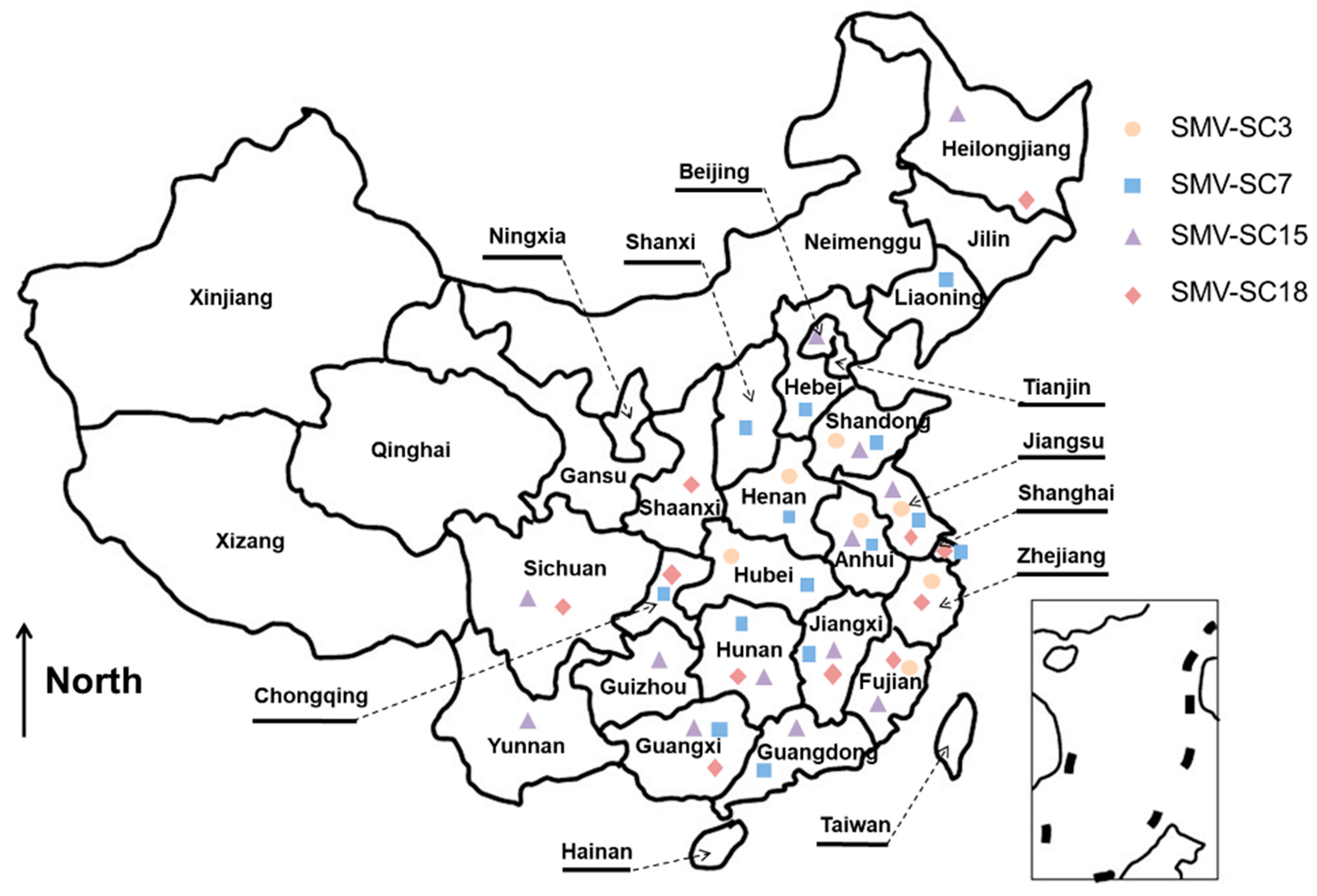
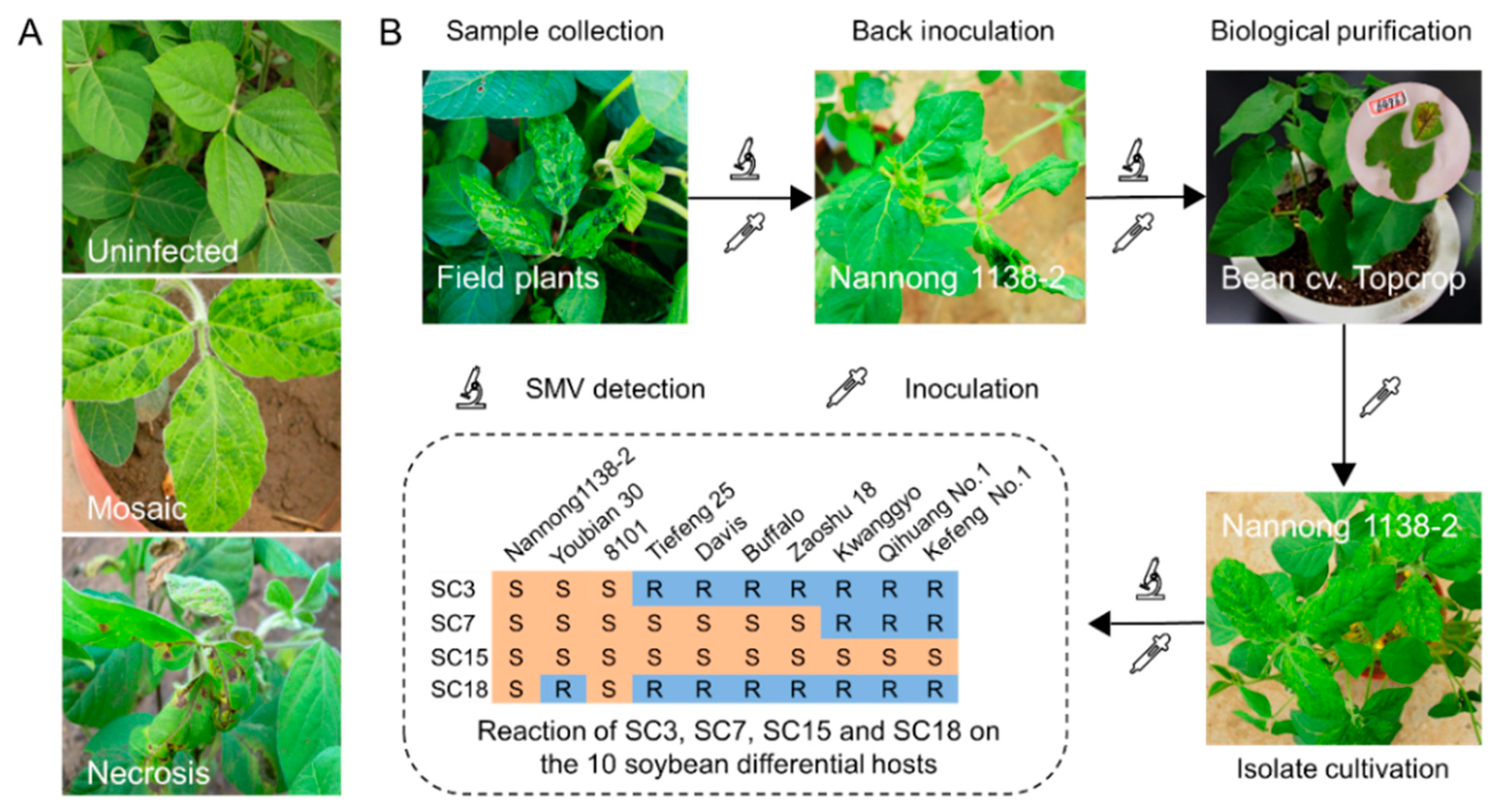
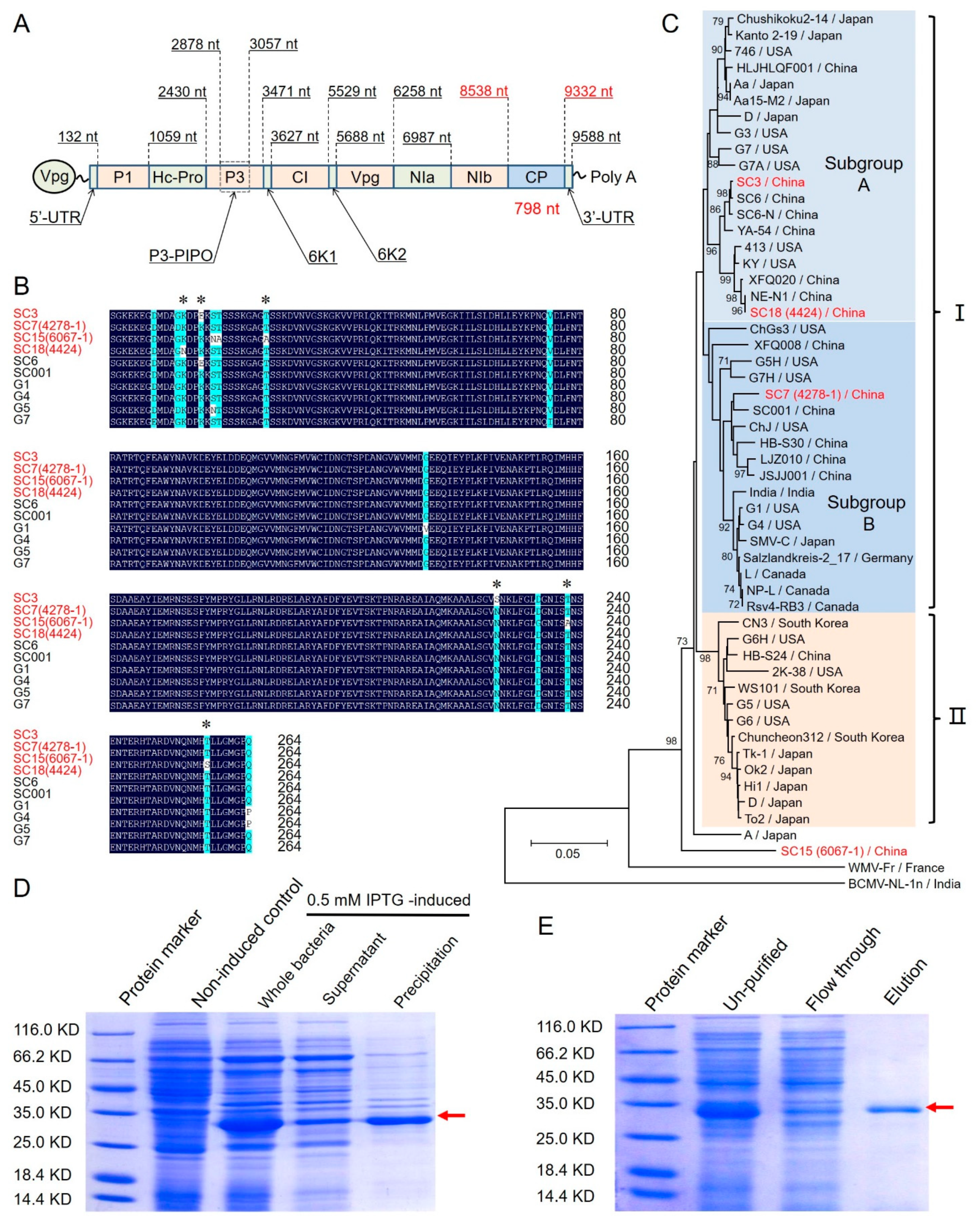
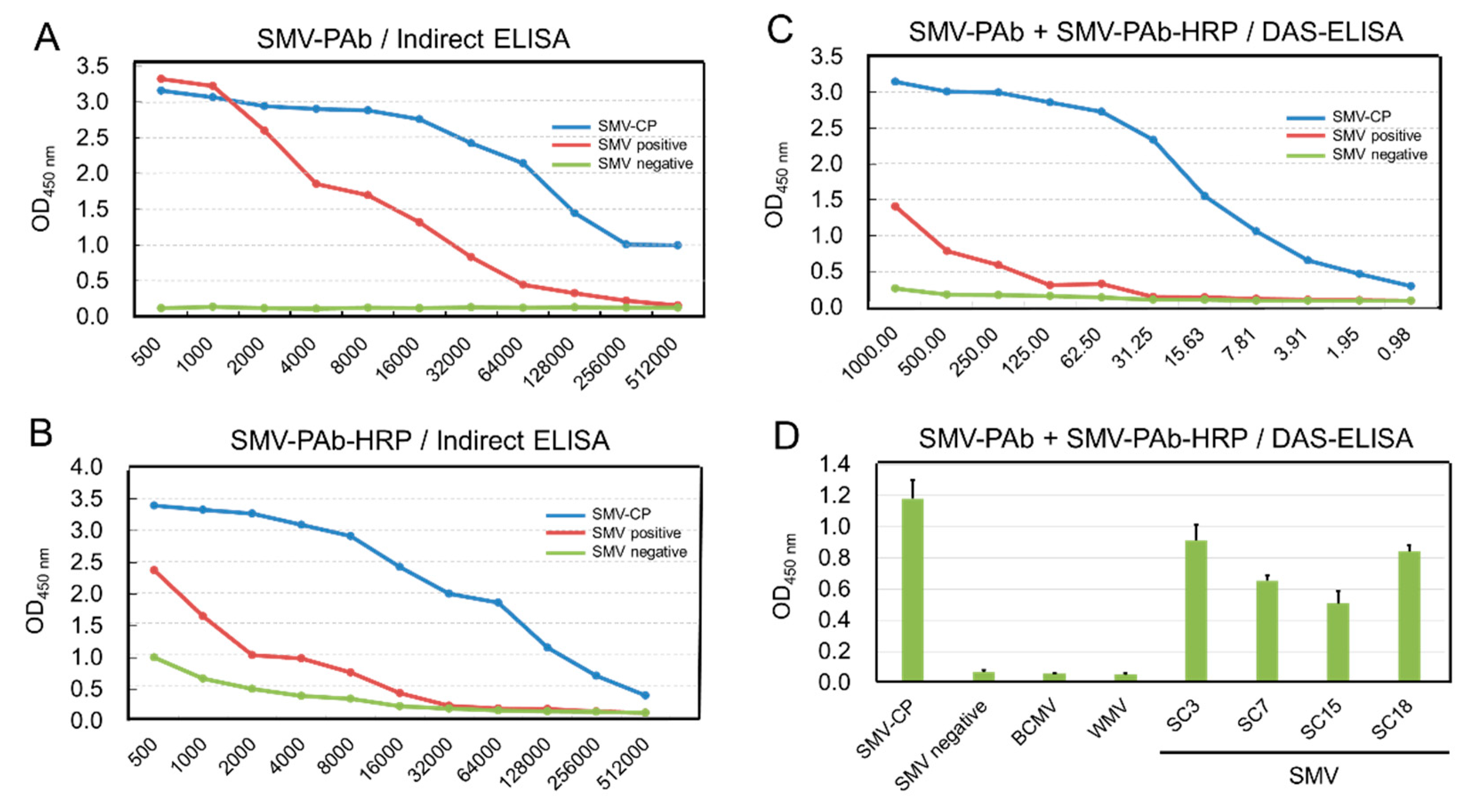
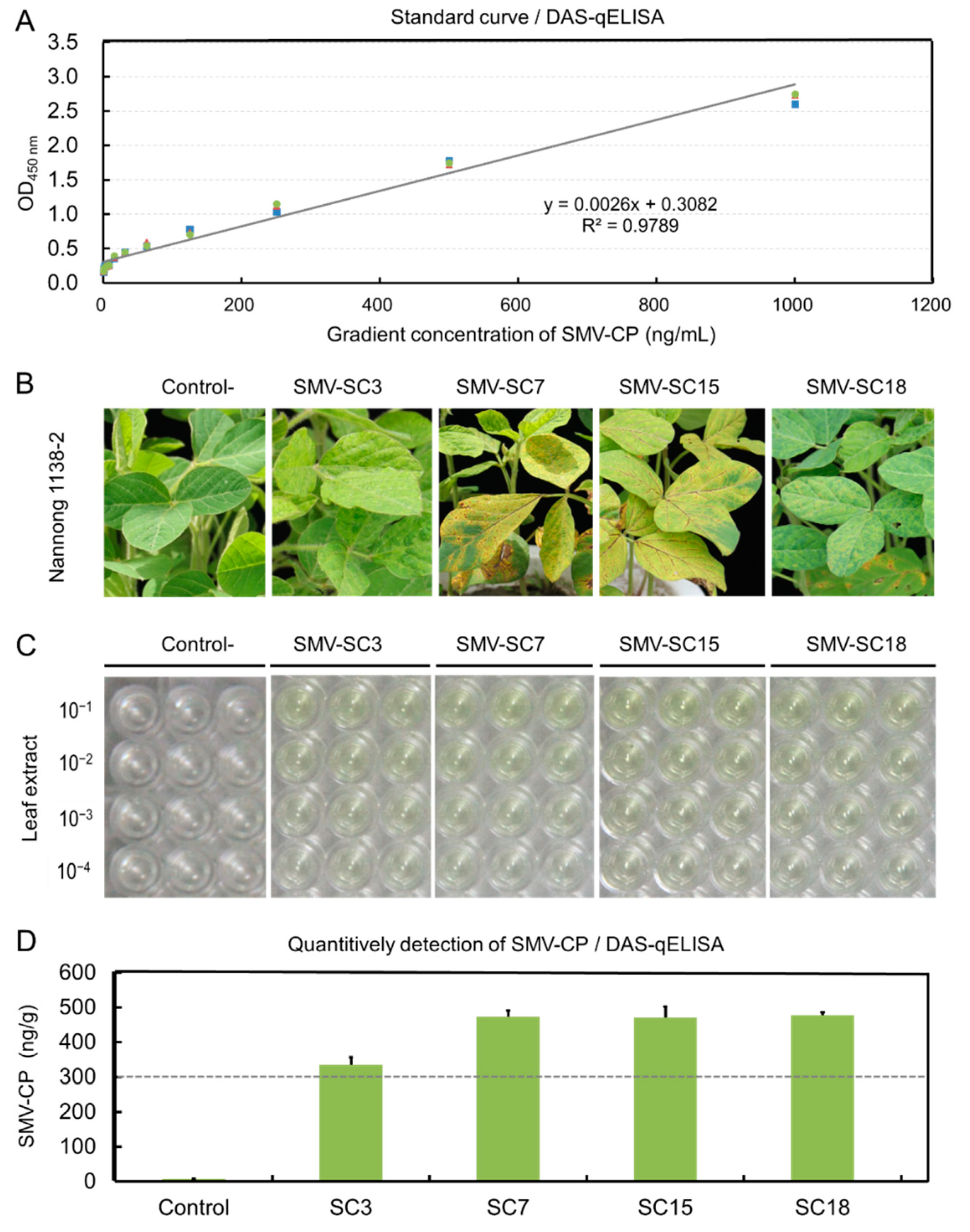
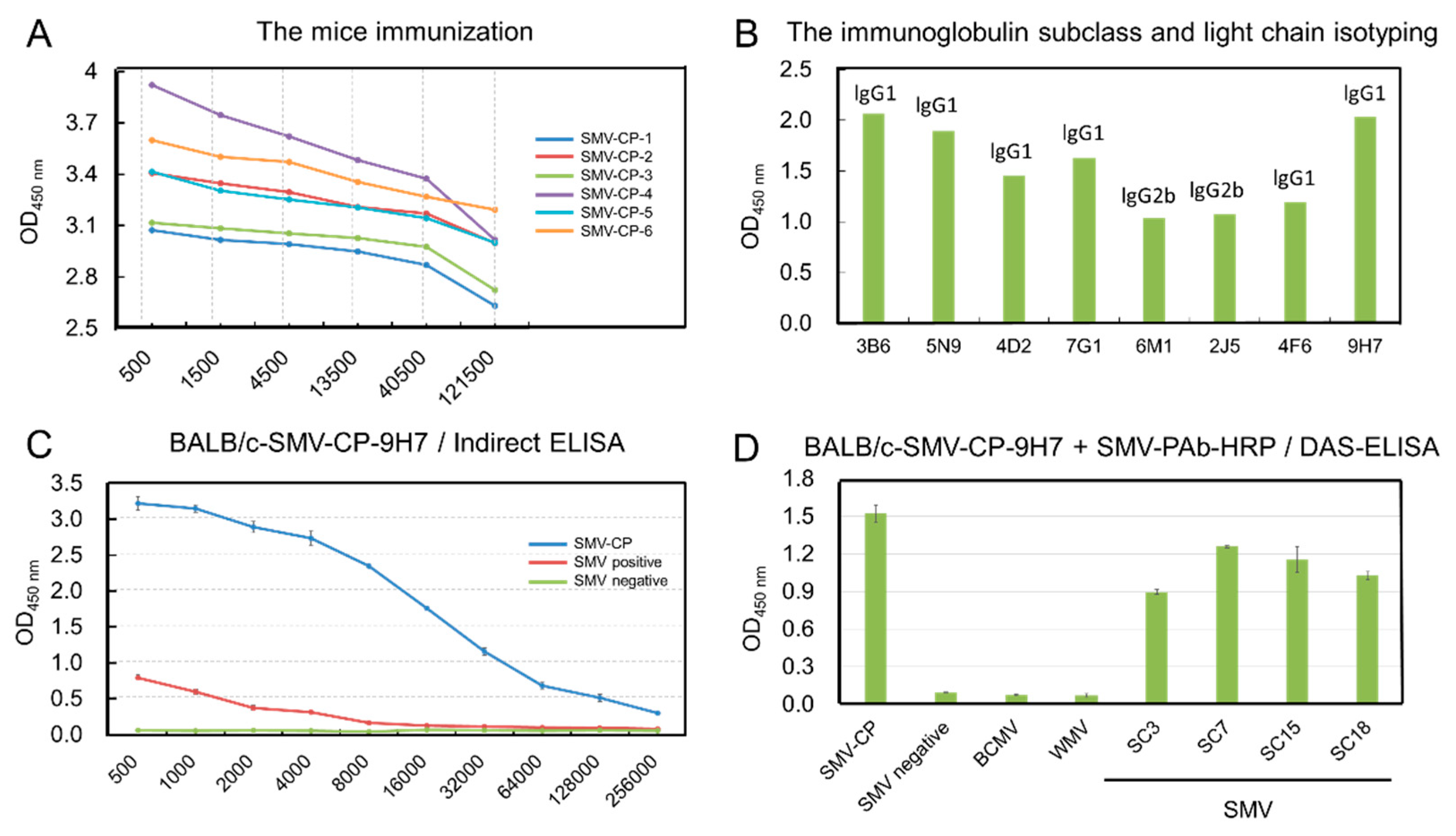
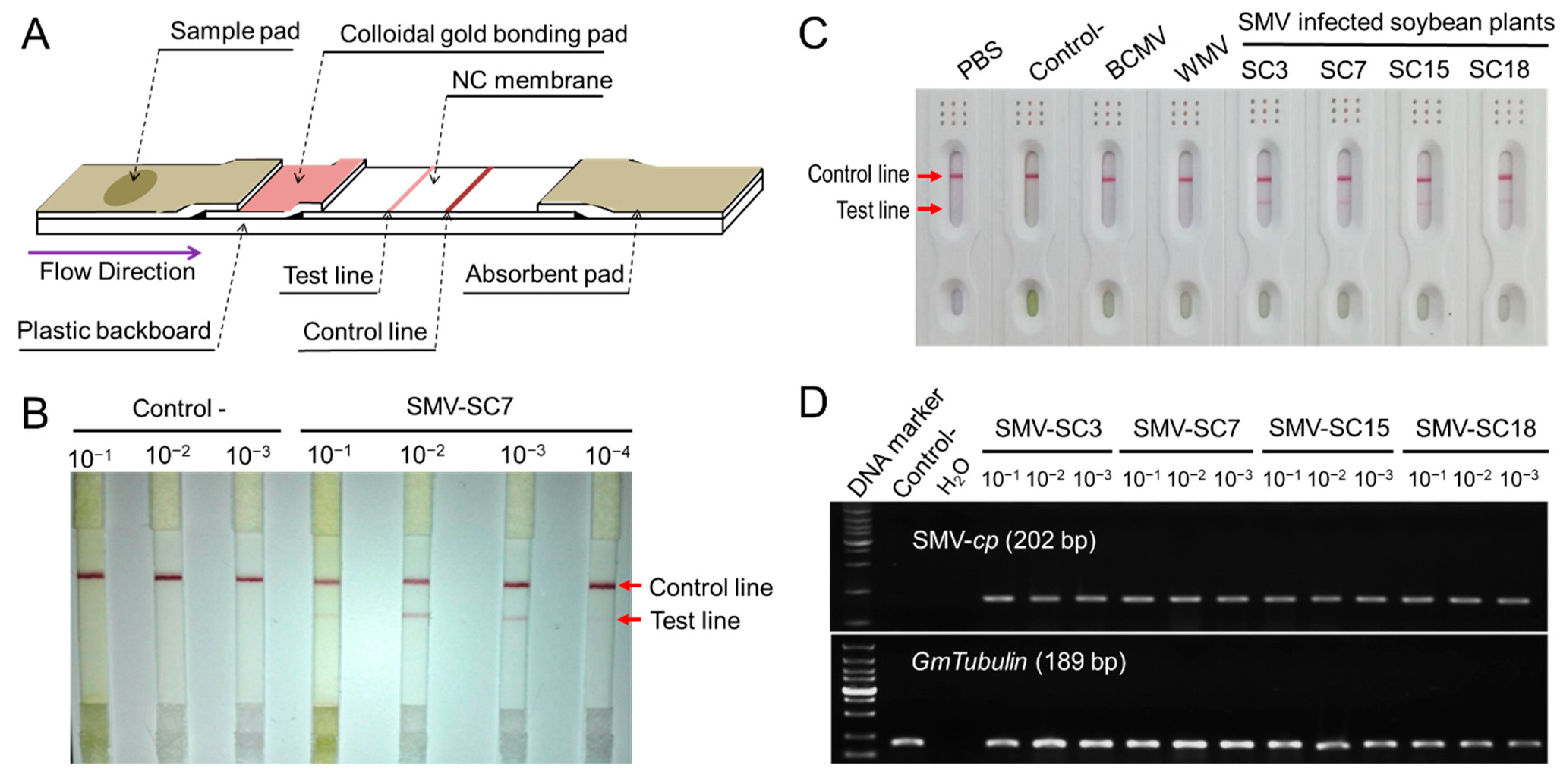

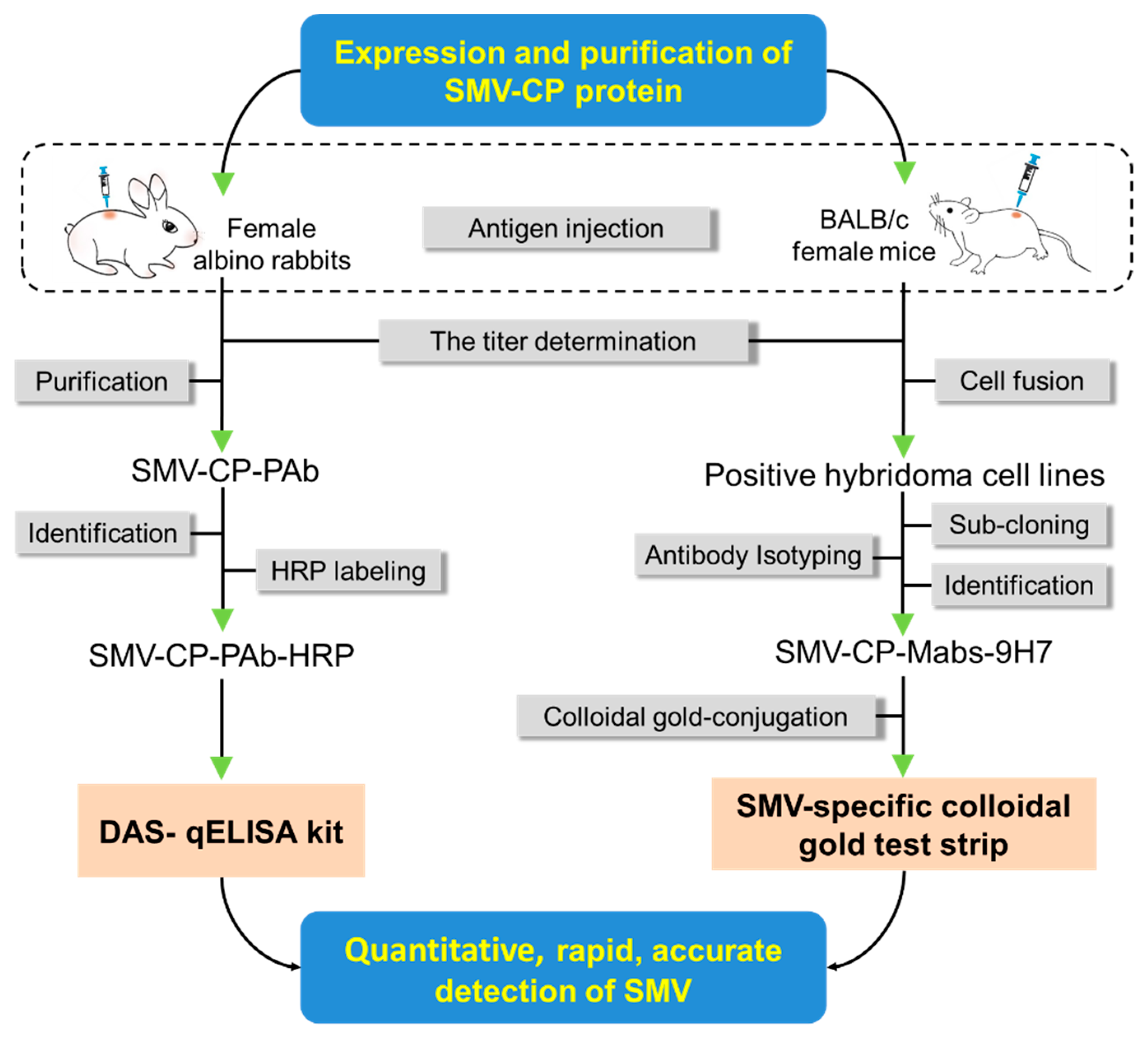
Publisher’s Note: MDPI stays neutral with regard to jurisdictional claims in published maps and institutional affiliations. |
© 2022 by the authors. Licensee MDPI, Basel, Switzerland. This article is an open access article distributed under the terms and conditions of the Creative Commons Attribution (CC BY) license (https://creativecommons.org/licenses/by/4.0/).
Share and Cite
Ren, R.; Wang, T.; Gao, L.; Song, P.; Yang, Y.; Zhi, H.; Li, K. Development of Comprehensive Serological Techniques for Sensitive, Quantitative and Rapid Detection of Soybean mosaic virus. Int. J. Mol. Sci. 2022, 23, 9457. https://doi.org/10.3390/ijms23169457
Ren R, Wang T, Gao L, Song P, Yang Y, Zhi H, Li K. Development of Comprehensive Serological Techniques for Sensitive, Quantitative and Rapid Detection of Soybean mosaic virus. International Journal of Molecular Sciences. 2022; 23(16):9457. https://doi.org/10.3390/ijms23169457
Chicago/Turabian StyleRen, Rui, Tao Wang, Le Gao, Puwen Song, Yunhua Yang, Haijian Zhi, and Kai Li. 2022. "Development of Comprehensive Serological Techniques for Sensitive, Quantitative and Rapid Detection of Soybean mosaic virus" International Journal of Molecular Sciences 23, no. 16: 9457. https://doi.org/10.3390/ijms23169457
APA StyleRen, R., Wang, T., Gao, L., Song, P., Yang, Y., Zhi, H., & Li, K. (2022). Development of Comprehensive Serological Techniques for Sensitive, Quantitative and Rapid Detection of Soybean mosaic virus. International Journal of Molecular Sciences, 23(16), 9457. https://doi.org/10.3390/ijms23169457






